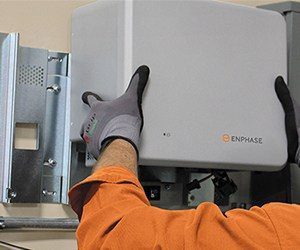Australia’s love of rooftop solar looks to be extending to battery storage, according to the results of a new poll – and for the all same reasons: that it will reduce their household’s reliance on increasingly expensive grid electricity, and cut soaring power bills.
The Reachtel poll, commissioned by the Climate Council, found that 74 per cent of people surveyed from across Australia expect household batteries to be commonplace in homes within the next decade.
More than half of those people, when asked about the key motivation for households adding battery storage to rooftop solar, said to “reduce power bills”.
Interestingly, 38 per cent of the survey respondents said they already owned rooftop solar – and more than two-thirds of that number (68%) said they were considering adding a battery.
This mirrors the findings of industry analysts SunWiz, whose latest data shows a surge in battery storage uptake among Australian households, driven mainly by high electricity prices.
According to the SunWiz 2017 Mid-Year Battery Report, published on Wednesday, more than 7000 battery systems were installed across the nation in the first six month of the year – surpassing the 6500 sales recorded for all of 2016 – and track to pass 20,000 by the year’s end.
“Once we hit a tipping point in payback time, the sales of household batteries will skyrocket – becoming as common as the backyard swimming pool is today in the years ahead,” said SunWiz founder and report author Warwick Johnston.
Taking it one step further, Climate Council chief Amanda McKenzie believes batteries will be as ubiquitous as dishwashers in Australian homes, as prices fall and home owners get wise to the savings they can generate.
“Australians love rooftop solar, and most now expect home battery storage to be as commonplace as dishwashers in our homes in a decade,” said McKenzie in comments on the battery poll on Thursday.
“Rising energy prices and a lack of a Federal energy plan are driving many people to take back control of energy. We’re getting smart to the fact that our energy system is changing.”
Indeed, the poll also found a general understanding among respondents of the importance of battery storage at the grid scale, too, with 55 per cent agreeing that installations like the Tesla big battery in South Australia will be commonplace in a decade, too.
Another 52 per cent said they now understood that large-scale energy storage was key to enabling wind and solar to provide “dispatchable” power to the wholesale electricity market.
And asked about the key benefits of large-scale battery storage, 25 per cent said making the energy system more reliable; 24 per cent said it would make electricity cheaper; and 19 per cent said it would make the power system more efficient
“Battery storage actually solves many problems – from storing excess energy, smoothing out spikes in demand and re-dispatching power during peak load times – to improving reliability,” said energy market veteran and Climate Councillor, Andrew Stock.
“It is encouraging to see that the public already has a solid grasp of the vital role of storage for a clean, affordable energy system,” he added.
“The combination of rising energy prices and the plunging cost of lithium-ion batteries have created a tipping point for Australia’s use of battery storage.”
For McKenzie, the poll results also reflect a disconnect between a federal government still wedded to the concept of fossil-fueled baseload power, and voters who understand where the energy market is headed.
“It’s clear that Australians are on board with using smart 21st century technology to cut costs, improve efficiency and reliability,” McKenzie said.
“We are the sunniest country in the world and one of the windiest, we also have significant lithium resources, Australia can be an energy powerhouse.”
The national ReachTel survey of 1,928 Australians was completed on the 28th August 2017 and commissioned by the Climate Council.
This article was originally published on RenewEconomy’s sister site, One Step Off The Grid, which focuses on customer experience with distributed generation. To sign up to One Step’s free weekly newsletter, please click here.









